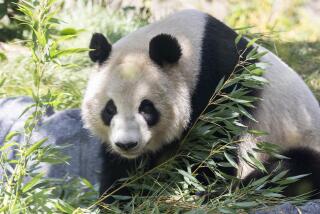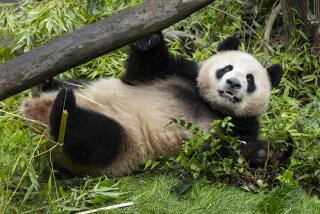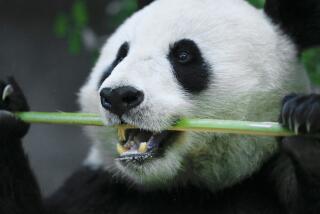THE PANDAS OF WOLONG
- Share via
CHENGDU, China — High in the mountains of western China, on steep, almost inaccessible terrain, the last giant pandas roam dense forests of bamboo, conifer and birch. Enigmatic creatures seldom seen by humans, they survive in several reserves in small, isolated groupings.
Recently opened to the public, the Wolong Natural Reserve here in Sichuan Province, 200 miles from the border of Tibet, is the largest of these areas. Wolong and a few other refuges are the last stand not only for the giant panda but for other rare species such as the golden monkey, the tragopan pheasant and the giant panda’s small raccoon-like cousin, the red panda.
Chengdu, the capital of Sichuan, is the jumping-off place for panda country, also for travelers heading to Tibet. About 1,000 miles inland from Shanghai and a little more than 900 miles from Beijing, this prosperous city lies at the western edge of China’s breadbasket. Teddy Roosevelt, son of President Theodore Roosevelt, came through Chengdu on a hunting expedition with his brother Kermit in 1928 and shot a panda. Agreeing to fire simultaneously, the two share the dubious honor of being the first white men to kill a giant panda.
From Chengdu the road to Wolong leads west through intensely cultivated fields where farmers winnow their rice on the surface of the asphalt roads. Occasionally one sees a neglected pagoda; a tree sprouts from the roof of one.
Beyond the rural town of Guanzian one crosses the path of the Long March, the strategic retreat of the Red Army before the forces of Chiang Kai-shek in 1935. At Luding, a bit south of the road to Wolong, you can still see the historic chain-link bridge dating from 1701, now reinforced with cables, where Mao Tse-tung, after a small but important victory, took his troops across the Dadu River.
The Mujiangpin tunnel at 3,000 feet above sea level marks the entrance to the Wolong Natural Reserve. Hewn from rock, it is a long, high tunnel with only occasional concrete walls and buttresses. Moisture drips the length of its dimly lit interior.
Beyond the tunnel the road follows the Zheng and Pitiao rivers, which at this altitude rush in torrents of white water. The road gradually worsens and vehicles are forced to the edge of sheer drop-offs to circumvent stones and landslides from the cliffs. On either side the Sichuan Mountains rise into the bright mist and high waterfalls plummet to the river. On clear days one can see the Four Maidens peak at the western end of the reserve.
About half of Wolong’s 800 square miles are above the timberline and are not considered suitable habitat for pandas. The lower altitudes are occupied by the farms of 4,000 Qiang. Broad-faced and swarthy, they resemble American Indians except for their distinctly Oriental eyes. As an officially recognized minority they are not subject to the one-child-per-family rule current in the rest of China, and so the population within the reserve continues to rise.
Reserve headquarters is in the village of Sauwan about an hour’s drive from the tunnel. A somber two-story hotel that once housed loggers accommodates naturalists and visitors. The immaculate rooms have high ceilings, a spittoon outside each door and a hot plate in the middle of the floor to take the chill off cold early mornings.
There are enameled washbasins and, on certain nights, there is hot water in the bathrooms down the hall, though bathing usually means taking up buckets of hot water from the heater downstairs.
Wolong’s famous panda breeding compound is nearby. The one-story structures, dubbed “pandaminiums,” are on the Pitiao flood plain beneath two steep mountains. Reached by a bridge, the gateway is carpeted with straw mats soaked in disinfectant, a precaution against rabies that might be brought in on people’s shoes.
The pens have both indoor and outdoor areas, and there is also a large tract of enclosed habitat nearby.
Pandas Seem Tame
Accustomed to visitors, the pandas seem almost tame. One of the breeding males, Quan Quan, was found in the wild unconscious from a head injury and taken to Wolong to be nursed back to health. Last year he mated with one of the resident females, and the reserve is celebrating the birth of its first cub to survive, Lan Tian, which means blue skies.
Even trained naturalists seldom see pandas in the wild. George Schaller, a panda authority affiliated with Wildlife Conservation International at the Bronx Zoo in New York City, was in Wolong two months before he glimpsed his quarry. Thus forewarned, it was the habitat that our group came to see.
There are two camps in the reserve to which the industrious visitor might climb. One is the Wu Yi camp, known to many from the 1983 National Geographic TV special “Save the Panda” (available in videocassette). It can be visited only by permission. We chose the Ying Ziong Gou camp in an adjacent valley, which required a less strenuous climb. Now abandoned, it was the site of early panda rescue efforts.
From beyond the village of Hetauping, the trail led steadily up beneath limestone overhangs and through tunnels (the second of which leaked so profusely that we needed rain gear). Small swifts darted overhead, and we saw river redstarts and spectacular red-billed magpies.
Higher up, sheer cliffs and trees rose above the fog like scenes from Chinese paintings, and occasionally beneath the overhangs we saw Chinese letters painted on the rocks, Cultural Revolution slogans now almost faded away.
Camp in Ruins
The camp, no longer in use, was falling into ruin. The pens for the pandas had begun to collapse, their interiors overgrown in bamboo. But the cinder-block rooms of the main house were dry. Cartoons and Chinese graffiti by the original researchers remained on the crumbling plaster walls. In the nearby cooking hut a wok still sat in a low stone hearth.
Beyond the camp, across a tumbling stream, we found the habitat we were looking for. There the arrow-leaf bamboo grows in thick stands, six to seven feet high. The narrow leaf of this species, which makes up the majority of the panda’s diet, gives clumps of the plant a light, feathery appearance. It is easy to see how pandas escape observation within its tangles, scurrying away on trails that amount to low tunnels through the dense undergrowth. To follow would mean scrambling on hands and knees, not an inviting prospect when it is on such trails that pandas are killed in spear traps laid by villagers for musk deer.
One of the questions puzzling scientists is what could have prompted the ancestors of pandas to give up meat for bamboo. Bamboo is an evergreen and thus always available (except when it dies off after a flowering, every 40 years or so), but pandas have the intestinal tracts of carnivores, with neither the length nor the necessary bacteria to extract nourishment efficiently from plants. As a result, pandas must eat up to 30 pounds of bamboo a day, leaves and stems, to obtain sufficient nutrition.
Marginal nutrition is thought to be the reason for their young being so small. A newborn cub is about the size of a hamster, thus being a relatively small investment for the mother if it does not survive.
Returning late from the mountain, a few of us saw two Qiang women in traditional black turbans, skirts and heavy aprons, working in a field. They invited us to their house, a rare treat for Westerners. We entered the spacious main room onto a wooden platform and stepped down to a floor of packed earth. Walls were of stone and mortar, and cured pork hung from the rafters. An ancestral shrine was built into one wall and an electric washing machine was against another.
Saw Panda in Field
Three generations lived in the house. The grandfather, a prosperous farmer, had yaks to pull his plow. He told of seeing a panda near his field in the winter of 1983, the year of the last bamboo die-off when many pandas starved. The panda, he said, did not disturb his crops or livestock.
Our group was led by Michael Robinson, director of the National Zoo in Washington, D.C. In Beijing, Robinson had received a telegram announcing the long-awaited birth of a panda at the National Zoo. (Since her arrival in the United States in 1972, Ling Ling had been bred several times, but cubs had never survived.) In high spirits we toasted the new panda with Chinese champagne.
The mood would change soon, however. After we returned to Chengdu from the Wolong preserve, a telex informed us that the baby panda at the National Zoo had died. An autopsy revealed bacterial infection. We were told that after an earlier loss, Ling Ling had tried to nurse an apple, a pathetic substitute for her dead infant.
One of a Kind
In Xian, ancient capital of China, we saw the rarest panda on earth. Where other pandas are black, Dan Dan, a young female, is brown, the only one of her kind and the pride of the Xian zoo. Members of our group were permitted into her cage to groom her, and I must confess to taking a few hairs from the keeper’s brush.
Pandas are not soft. Their fur has a stiff, wiry feel to it. The pads on their paws, including the false thumb, are very rough, and the claws very thick. The false thumb is an immovable spur of bone extending from the wrist, making it possible for the panda to grasp bamboo.
In earlier times pandas migrated whenever a bamboo die-off or other emergency forced them from their range. Such migrations are also essential for genetic diversity. Now movement between ranges is blocked by human habitation.
Many of the remaining panda habitats are thought to contain fewer than 20 animals. If so, those populations may be doomed. According to George Conway, director of the New York Zoological Society, establishing corridors of habitat to connect these isolated populations is the only hope for the pandas’ survival in the wild.
-- -- --
Wolong is open to the public, but permits are needed to visit the panda camps and see the breeding compound. These can be easily obtained through your hotel in Beijing or Chengdu. You may write to the Ministry of Forestry, Beijing, China, but responses are irregular at best. Regulations prohibit the use of motion picture or video cameras in the preserve. If you plan to climb to one of the camps, allow one or two days in Wolong to acclimate yourself to the high altitude.
Traveling in China is easiest with a group after permits have been obtained and a translator is provided. If you want to go to Wolong, U.S. Exchanges is the only agent in the United States to send groups. That agency can also help with individual travel, which is difficult unless you speak Chinese. The next panda trip to China organized by U.S. Exchanges, under the sponsorship of the St. Louis Zoological Park, includes visits to zoos in six major cities and is scheduled for Aug. 4, 1989. The cost will be $4,245.
For more information about the trip, contact Zoo Travel, St. Louis Zoo, Forest Park, St. Louis, Mo. 63110, (314) 781-0900. You can also write to U.S. Exchanges, 18100 Mack Ave., Grosse Pointe, Mich. 48224.
If you want to plan your own trip to Wolong, rooms at the Wolong Hotel are 30 yuan a night ($12 U.S.), with more expensive rooms costing up to 50 yuan. Contact Wolong Hotel, Wolong Natural Reserve, Wenchuan County, Sichuan Province, China.
Note: As the number of pandas in the wild continues to decline, poaching has become the most immediate threat to the species. In Wolong, the largest of the reserves, the population is estimated to have fallen 50% since 1976, to only 72 pandas. (The total number of pandas in China was estimated at 1,000 in 1976.)
Last February the Chinese Forestry Ministry recovered 146 panda skins in Sichuan Province, representing a loss of about one in every seven animals to poachers. More than 200 people were arrested in connection with the poaching, and 150 were still being sought. Sentences ranged from one year to life imprisonment.
Due to the drastic loss, the Washington, D.C.-based World Wildlife Fund has recommended that no further permits be given to exhibit pandas in the United States.
More to Read
Sign up for Essential California
The most important California stories and recommendations in your inbox every morning.
You may occasionally receive promotional content from the Los Angeles Times.










